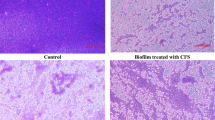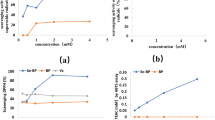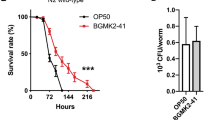Abstract
Objectives
To investigate the preventive effect of Lactobacillus casei HY2782 on toxicity induced by particulate matter (PM, inhalable particles less than 10 μm in diameter) in human intestinal CCD-18Co cells and a model animal Caenorhabditis elegans.
Results
L. casei HY2782 treatment prevented PM-induced intestinal cell death via cellular reactive oxygen species production and membrane disruption attenuation. PM significantly decreased the total number of eggs laid and the body bending activity of C. elegans, demonstrating PM toxicity. L. casei HY2782 treatment restored the reproductive toxicity and decline in locomotion activity induced by PM in C. elegans. Overall, L. casei HY2782 attenuated PM toxicity in vitro in cultured intestinal cells and in vivo in the model nematode.
Conclusion
Our study provides a potential clue for developing L. casei HY2782 probiotics that attenuate PM-induced cellular and physiological toxicity; however, further in-depth preclinical trials using mammalian animal models and clinical trials are required.





Similar content being viewed by others
References
Cha KH et al (2018) Effects of fermented milk treatment on microbial population and metabolomic outcomes in a three-stage semi-continuous culture system. Food Chem 263:216–224
Chung MC et al (2019) Fine particulate matter-induced toxic effects in an animal model of Caenorhabditis elegans. Aerosol Air Qual Res 19:1068–1078
Clark LC, Hodgkin J (2014) Commensals, probiotics and pathogens in the Caenorhabditis elegans model. Cell Microbiol 16:27–38
Daisley BA, Monachese M, Trinder M, Bisanz JE, Chmiel JA, Burton JP, Reid G (2019) Immobilization of cadmium and lead by Lactobacillus rhamnosus GR-1 mitigates apical-to-basolateral heavy metal translocation in a Caco-2 model of the intestinal epithelium. Gut Microbes 10:321–333
Forman HJ, Finch CE (2018) A critical review of assays for hazardous components of air pollution. Free Radic Biol Med 117:202–217
George Kerry R, Patra JK, Gouda S, Park Y, Shin HS, Das G (2018) Benefaction of probiotics for human health: a review. J Food Drug Anal 26:927–939
Harris KL, Myers JN, Ramesh A (2013) Benzo(a)pyrene modulates fluoranthene-induced cellular responses in HT-29 colon cells in a dual exposure system. Environ Toxicol Pharmacol 36:358–367
Jin X, Su R, Li R, Song L, Chen M, Cheng L, Li Z (2016) Amelioration of particulate matter-induced oxidative damage by vitamin c and quercetin in human bronchial epithelial cells. Chemosphere 144:459–466
Kamaladevi A, Balamurugan K (2016) Lactobacillus casei triggers a TLR mediated RACK-1 dependent p38 MAPK pathway in Caenorhabditis elegans to resist Klebsiella pneumoniae infection. Food Funct 7:3211–3223
Kang K et al (2011) A novel topoisomerase inhibitor, daurinol, suppresses growth of HCT116 cells with low hematological toxicity compared to etoposide. Neoplasia 13:1043–1057
Kim Y, Mylonakis E (2012) Caenorhabditis elegans immune conditioning with the probiotic bacterium Lactobacillus acidophilus strain NCFM enhances gram-positive immune responses. Infect Immun 80:2500–2508
Kim KH, Kabir E, Kabir S (2015) A review on the human health impact of airborne particulate matter. Environ Int 74:136–143
Kim JY et al (2019) 3,3'-Diindolylmethane improves intestinal permeability dysfunction in cultured human intestinal cells and the model animal Caenorhabditis elegans. J Agric Food Chem 67:9277–9285
Kish L et al (2013) Environmental particulate matter induces murine intestinal inflammatory responses and alters the gut microbiome. PLoS ONE 8:e62220
Kobatake E, Nakagawa H, Seki T, Miyazaki T (2017) Protective effects and functional mechanisms of Lactobacillus gasseri SBT2055 against oxidative stress. PLoS ONE 12:e0177106
Lee SY, Kang K (2017) Measuring the effect of chemicals on the growth and reproduction of Caenorhabditis elegans. J Vis Exp. https://doi.org/10.3791/56437
Lee SY, Kim JY, Jung YJ, Kang K (2017) Toxicological evaluation of the topoisomerase inhibitor, etoposide, in the model animal Caenorhabditis elegans and 3T3-L1 normal murine cells. Environ Toxicol 32:1836–1843
Li CP, Qin G, Shi RZ, Zhang MS, Lv JY (2013) Ginsenoside Rg1 reduces toxicity of PM(2.5) on human umbilical vein endothelial cells by upregulating intracellular antioxidative state. Environ Toxicol Pharmacol 35:21–29
Li X et al (2019) Colonic injuries induced by inhalational exposure to particulate-matter air pollution. Adv Sci 6:1900180
Liu Y, Liu X, Wang Y, Yi C, Tian J, Liu K, Chu J (2019) Protective effect of Lactobacillus plantarum on alcoholic liver injury and regulating of keap-Nrf2-ARE signaling pathway in zebrafish larvae. PLoS ONE 14:e0222339
Mu G, Li H, Tuo Y, Gao Y, Zhang Y (2019) Antioxidative effect of Lactobacillus plantarum Y44 on 2,2'-azobis(2-methylpropionamidine) dihydrochloride (ABAP)-damaged Caco-2 cells. J Dairy Sci 102:6863–6875
Mutlu EA et al (2011) Particulate matter air pollution causes oxidant-mediated increase in gut permeability in mice. Part Fibre Toxicol 8:19
Nakagawa H et al (2016) Effects and mechanisms of prolongevity induced by Lactobacillus gasseri SBT2055 in Caenorhabditis elegans. Aging Cell 15:227–236
Sanders ME et al (2014) Probiotics and prebiotics: prospects for public health and nutritional recommendations. Ann N Y Acad Sci 1309:19–29
Sun L, Wu Q, Liao K, Yu P, Cui Q, Rui Q, Wang D (2016) Contribution of heavy metals to toxicity of coal combustion related fine particulate matter (PM2.5) in Caenorhabditis elegans with wild-type or susceptible genetic background. Chemosphere 144:2392–2400
Wang G, Li X, Zhao J, Zhang H, Chen W (2017a) Lactobacilluscasei CCFM419 attenuates type 2 diabetes via a gut microbiota dependent mechanism. Food Funct 8:3155–3164
Wang X, Hui Y, Zhao L, Hao Y, Guo H, Ren F (2017b) Oral administration of Lactobacillus paracasei L9 attenuates PM2.5-induced enhancement of airway hyperresponsiveness and allergic airway response in murine model of asthma. PLoS ONE 12:e0171721
Yu L et al (2016) Potential of Lactobacillus plantarum CCFM639 in protecting against aluminum toxicity mediated by intestinal barrier function and oxidative stress. Nutrients 8:783
Zhai Q et al (2019) Lactobacillus plantarum CCFM8661 modulates bile acid enterohepatic circulation and increases lead excretion in mice. Food Funct 10:1455–1464
Zhao Y, Lin Z, Jia R, Li G, Xi Z, Wang D (2014) Transgenerational effects of traffic-related fine particulate matter (PM2.5) on nematode Caenorhabditis elegans. J Hazard Mater 274:106–114
Zhao Z et al (2019) Lactobacillus plantarum NA136 improves the non-alcoholic fatty liver disease by modulating the AMPK/Nrf2 pathway. Appl Microbiol Biotechnol 103:5843–5850
Acknowledgements
This research was funded by intramural grants from the Korea Institute of Science and Technology (KIST; 2Z05650, 2Z06220) and Korea Yakult. We thank Ms. Seemi Tasnim Alam and Ms. Tram Anh Ngoc Le (KIST, South Korea) for technical assistance related to C. elegans experiments
Supporting information
Supplementary Fig. 1 Effect of L. casei HY2782 feeding on the growth retardation induced by PM in C. elegans.
Author information
Authors and Affiliations
Corresponding author
Ethics declarations
Conflict of interest
A portion of the technology described in this article (Korea patent, 10–2017-0177415) has been transferred from KIST to Korea Yakurt Co., Ltd. The funding sponsors had no roles in the design of the study; in the collection, analyses, or interpretation of data; or in the writing of the manuscript.
Ethical approval
This study does not contain any experiments involving human or mammalian subjects.
Additional information
Publisher's Note
Springer Nature remains neutral with regard to jurisdictional claims in published maps and institutional affiliations.
Electronic supplementary material
Below is the link to the electronic supplementary material.
Supplementary Fig. 1
Effect of L. casei HY2782 feeding on the growth retardation induced by PM in C. elegans. (PDF 89 kb)
Rights and permissions
About this article
Cite this article
Kim, J.Y., Lee, S.Y., Jung, SH. et al. Protective effect of Lactobacillus casei HY2782 against particulate matter toxicity in human intestinal CCD-18Co cells and Caenorhabditis elegans. Biotechnol Lett 42, 519–528 (2020). https://doi.org/10.1007/s10529-020-02814-3
Received:
Accepted:
Published:
Issue Date:
DOI: https://doi.org/10.1007/s10529-020-02814-3




